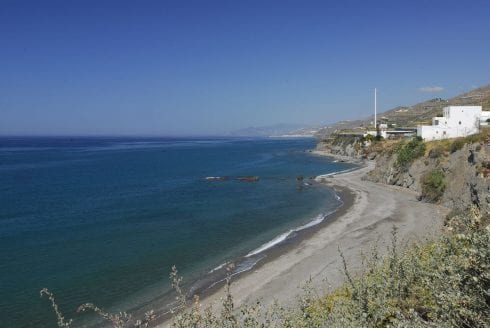I AM standing outside a jumble of small shops and apartments on a busy street in the centre of Almeria. My boyfriend, a Spanish native and something of a culinary whizz, is my guide for a foodie tour of the city.
We are to visit Mercado Central a Domicilio, just a stone’s throw from where his parents live and work. The stalls on Circunvalacion Ulpiano Diaz are piled high with colourful fruit, vegetables and fish just off the boat. This is pure Andalucia – old ladies drag shopping bags filled with curls of green lettuce, arguing over prices and friends drink bottles of red wine while tucking into free plates of fleshy, pink steak.
While Almeria has its fair share of plush five-star hotels – and its own airport – few tourists go there. Most head to the Costa del Sol, the rambling hills of Granada or the heat of Sevilla. But they are missing out. Dive into Almeria’s food scene and you will soon feel a million miles away from Spain’s tourist trail – and ready for a unique culinary adventure.
I’ve enlisted my boyfriend Abel to play the role of tour guide since he knows the streets better than anyone. He grew up here and makes regular trips back to visit his parents, as well as various aunties, cousins and siblings. So far, so Spanish.
I suspect that little has changed since he was born here 20-something years ago. His favourite family-run restaurants are still packed to the rafters, and he knows most tapas menus off by heart.
As my boyfriend chats to the butcher, his family’s favourite, I take in the hustle and bustle of the market. The morning light is luminous and the mood is excitable. Shoppers’ hands are puffy and red from carrying the weight of their wares, the bruised outer layer of thin-skinned aubergines peeking from their bags.
I see huge stalls loaded with fresh produce: the vivid greens of cucumbers, the vibrant naranjas, glistering artichokes and mushrooms still sheathed in dirt. Silver hooks loaded with fresh meat, chorizo sausages and legs of jamon and fish stalls piled high with crimson tuna.
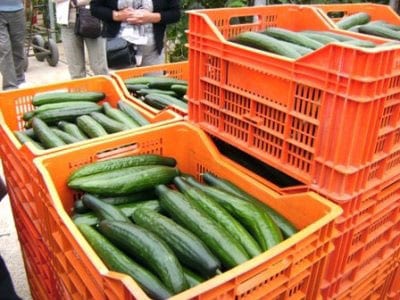
You can buy anything here, my boyfriend tells me, even stiff yellow chicken-legs and rabbits completely shorn, eyes still bulging.
Across the way, heavenly aromas waft from a shop filled with roasting coffee, where cafe solos are served along with tostadas and tomate.
Those tomatoes are Almeria’s finest export and are grown with peppers, cucumber and melons in the city’s famous greenhouses which make up the famous ‘sea of plastic’. Visible from space, Almeria’s greenhouses produce an estimated 3.5 tonnes of veg each year and together with Granada, it supplies about 50% of the European market.
In short, the produce is extraordinary. Thick, juicy and enormous, packed with flavour and grown all year round in the desert.
In the markets tomatoes of every colour stacked high, as if on a throne, prime for tumbling. Each one perfect – yellow, green, orange, red-purple, mottled, shiny, dotted, enormous – and all grown locally in Almeria.
“This is the Almeria, the part that tourists don’t see,” Abel says. “They might see the sea of plastic on the news, but they never come to visit themselves, to taste the fresh produce or shop directly from the farmers the same day it was picked. I like to bring visitors to remind us how lucky we are.”
There is another reason that he likes to visit. The beaches, undisturbed by tourists, are among the best in Spain.
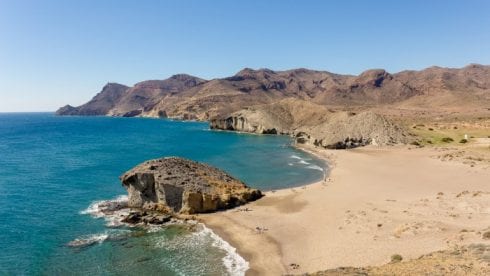
Abel was born on the seafront, close to the university, and his parents still own the apartment where he grew up, as well as a cortijo in the desert where olives and pomegranates grow freely. Most of his relatives live in villages across Almeria’s coastline — one of his many cousins owns Isoletta, a restaurant which Abel believes boasts the best seafood paella in a Andalucia and he loves to enlist friends to take there for a meal – it also gives him an opportunity to pop in and say hello. Indeed, this forgotten corner of Cabo de Gata boasts an amazing selection of restaurants in a tiny radius: Sobre La Marcha for cocktails, La Ola for seafood and Food truck La Isleta for proper Spanish street food.
At the market we buy meat, artichokes, peppers, onions – and of course tomatoes – to bring home for his mother. But the market is just the beginning of our foodie day out. The next stop is Abel’s favourite tapas joint La Runda. I order a refreshing tinto de verano (despite the January chill, the sun is shining) and the waiter presents us with the tapas menu – all free with our drinks. I selected the best seafood they had to offer: gamba roja poco heca, quisquillas crudas and cigalas, all caught on the Almeria coast that morning. After all the talk of food we are ravenous, so it is the perfect end to our morning.

Like all his friends, Abel knows how to cook – exquisite meals using simple produce – by heart. His mother and abuela taught him how to make traditional Spanish dishes as a child and his dad encouraged him to learn and appreciate that art of cutting a jamon. You’ll rarely find their kitchen without a leg of ham taking centre stage on the countertop.
A cooking lesson from his mum is an inevitable part of the tour and she patiently explains to me the difference between setas and champiñones. While the mushrooms vary wildly in texture, she likes to cook them both the same, swirling in their own juices, with a tonne of olive oil and garlic to help bring out their flavour.
Then we cook the Almerian grown beef, fried in more thick olive oil to a colour paler than wine but just as vital, the most delicious meat in all of Spain.
“So simple?” I asked softly, as I cut up chunks of bread.
“So simple, Cristina! But,” she shrugged, “you know, with the right ingredients -“
“You never prepare a meal in Almeria without first going to the market for fresh ingredients,” Abel said. “Eating is about food but a cultural experience as well.”
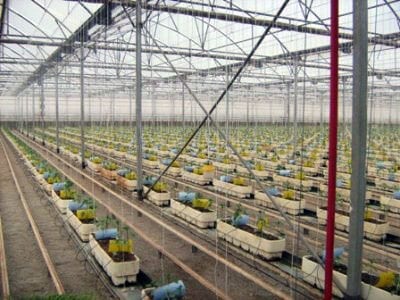
When his mum is not cooking up a storm, his father takes over, serving up enormous slabs of perfectly cooked beef and juicy slices of jamon, so succulent they almost taste like butter. Do they always indulge like this? “Yes,” his mum replied. “Which is why on Wednesdays we only eat fruit for lunch,” she said, eyeing up an apple miserably.
We escaped the fruit salad to dine at, La Consentida, which is fantastic, and recognised widely as the best place to eat in town. And no wonder – it has a fabulous menu of meat, fish, and veggie tapas that are truly exceptional. To add to the fun, each tapa is named after a famous female celebrity and we took great delight in guessing why the owners had chosen to name the sensual cheese and meat dish in honour of Scarlett Johansson and the veggie salad after Sarah Jessica Parker.
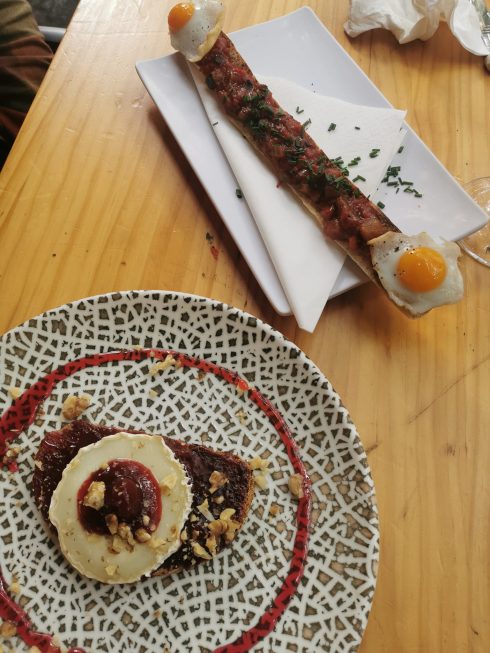
My favourites are the goats cheese served with walnuts and spicy jam chilli spread on rye bread or the Penelope Cruz, a long, thin tostada topped with tomato salsa, chives and two tiny quail eggs. Deciding what to order is a feat in itself.
After the day in Almeria it is time to leave for the Tadeo and embark on an adventure to the desert for a visit to Oasys, where Clint Eastwood filmed his spaghetti westerns.
It is the end of my Almeria adventure, but with an open fire dinner, a visit to Mini Hollywood and the promise of sunset in the desert still to come, I can’t wait to get started on the next.
READ ALSO:
Click here to read more News from The Olive Press.


